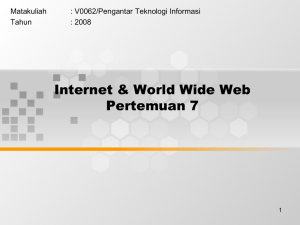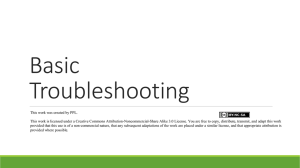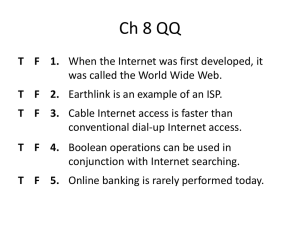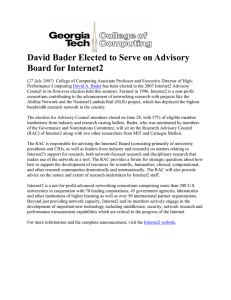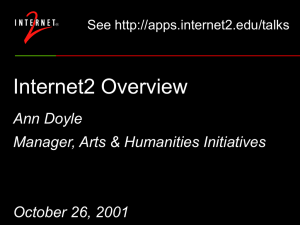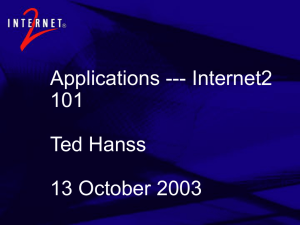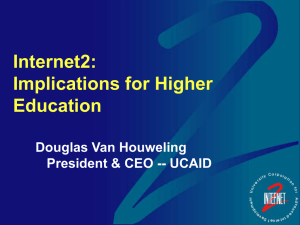What is the Internet?
advertisement
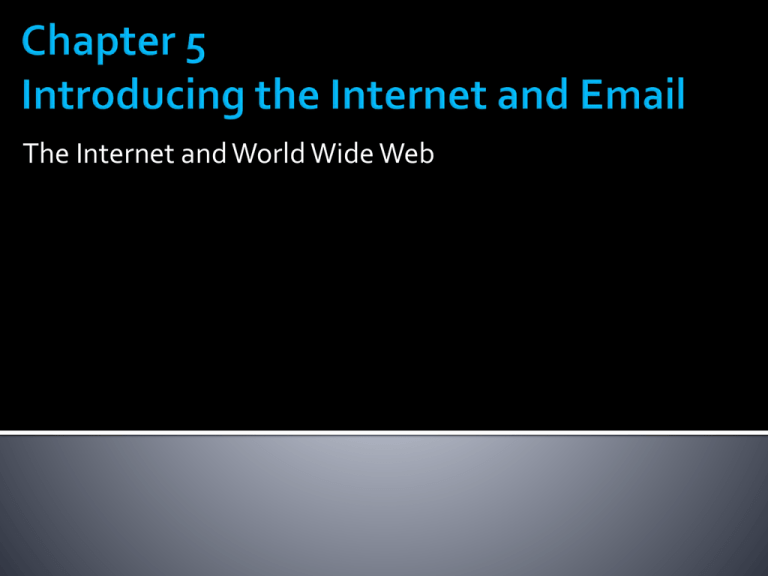
The Internet and World Wide Web Understand how the Internet evolved Describe common Internet communication methods and activities Setting up your computer to use the Internet The Internet is a worldwide collection of networks that link together millions of businesses, governments, educational institutions, and individuals. Each of these networks provides resources and data that add to the abundance of goods, services, and information accessible via the Internet. Topics Covered: From ARPANET to Internet2 The World Wide Web Internet2 The Internet Community Today The Pentagon’s Advanced Research Projects Agency (ARPA) begins a project to network computers around the country, ARPNET. 1969 The first computers are connected to the ARPNET 1972 The first e-mail is sent 1981 the IBM PC is introduced 1984 Apple introduces the McIntosh computer In 1989, a researcher named Tim Berners-Lee proposed the idea of the World Wide Web (WWW) as a way to organize information in the form of pages linked together through selectable text or images (today’s hyperlinks) on the screen. 1992 Windows 3.1 is introduced 1993 a graphic interface for the WWW is created called Mosaic. This will become Netscape Navigator. E-mail File Transfer Protocol World Wide Web Streaming media Chat rooms and message boards. These services are called protocols in the computer world. A protocol is a standard procedure for regulating data transmission between computers WWW FTP E-mail Streaming Media The World Wide Web, or simply Web, consists of a worldwide collection of electronic documents, Web pages, organized into Web sites. A growing number of today’s Web-based applications and services are referred to as Web 2.0 applications. Web 2.0 uses the Web as a platform to deliver rich applications that enable people to collaborate, socialize, and share information online, including; cloud computing social networking sites Podcasts Blogs Wikis. Internet2 is a consortium of researchers, educators, and technology leaders from industry, government, and the international community that is dedicated to the development of revolutionary Internet technologies. Internet2 uses high-performance networks linking over 200 member institutions to deploy and test new network applications and capabilities. Users - People who use the Internet to retrieve content or perform online activities, Internet service providers (ISPs) - Businesses or other organizations, including telephone, cable, and satellite companies, that provide Internet access to others, Internet content providers - are imposed on what information is published on Web servers located in China, as well as on the in-formation Application service providers (ASPs) - companies that manage and distribute Web- based software services to customers over the Internet. Infrastructure companies - The enterprises that own or operate the paths or “ roadways” along which Internet data travels, such as the Internet backbone and the communications networks connected to it. Hardware and software companies - The organizations that make and distribute the products used with the Internet and Internet activities. Governments - The ruling bodies of countries that can pass laws limiting both the information made available via Web servers located in a particular country and the access individuals residing in that country have to the Internet. Key Internet organizations - Other organizations that are responsible for many aspects of the Internet including; Internet Society (ISOC) ICANN ( Internet Corporation for Assigned Names and Numbers) The World Wide Web Consortium ( W3C) is a group of over 450 organizations dedicated to developing new protocols and specifications to promote the evolution of the Web and to ensure its interoperability. Topics Covered: Other Types of Online Communications Blogs, Wikis, and Other Types of Online Writing Cookies Instant messaging (IM) allows you to exchange real- time typed messages with people on your buddy list— a list of individuals such as family, friends, and business associates whom you specify. Text messaging is a form of messaging frequently used by mobile phone users. Tweeting, sometimes referred to as microblogging, is a free service that allows members to post short updates—called tweets— about what they are doing at any moment. Today, the standard term for placing telephone calls over the Internet or any other type of data network is Voice over Internet Protocol (VoIP) and it can take many forms. Web conferences typically take place via a personal computer or mobile phone and are used by businesses and individuals. Webinars (Web seminars) are similar to Web conferences, but typically have a designated presenter and an audience. A social networking site can be loosely defined as any site that creates a community of individuals who can communicate with and/or share information with one another. A blog—also called a Web log—is a Web page that contains short, frequently updated entries in chronological order, typically as a means of expression or communication. Wikis, named for the Hawaiian phrase wiki wiki meaning quick, are a way of creating and editing collaborative Web pages quickly and easily. Financial transactions online including; Selling goods and services Banking Buying and selling stocks. Many Web pages today use cookies—small text files that are stored on your hard drive by a Web server—to identify return visitors and their preferences. Third-party cookies are cookies placed on your hard drive by a company other than the one associated with the Web page that you are viewing—typically a Web advertising company. Topics Covered: Selecting the Type of Device Choosing the Type of Connection and Internet Access Selecting an ISP Setting Up Your Computer The Internet can be accessed using a variety of devices. Most common typed of Internet connections for personal use today: Conventional dial-up: Dial-up via standard telephone lines Cable: Fast, direct via cable TV lines DSL: Fast, direct via standard telephone lines Satellite: Fast, direct via the airwaves and a satellite dish Fixed wireless: Fast, direct available in some areas via the airwaves BoF or FTTP: Very fast, direct via fiber-optic networks Mobile wireless: via a mobile phone network A Wi-Fi hotspot is a location with a direct Internet connection and a wireless access point that allows users to connect wirelessly (via Wi-Fi) to the hotspot to use its Internet connection. The type of device used, the type of Internet connection and service desired, and your geographical location will likely determine your ISP options. Things to consider’; Services Speed Support Cost The specific steps for setting up your computer to use your selected type of Internet connection depend on the type of device the type of connection the ISP you have chosen to use.

